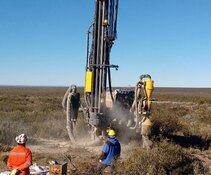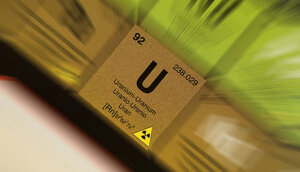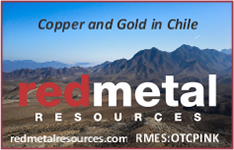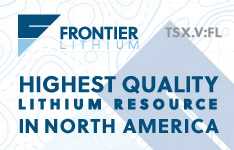The new year offers new opportunities for investors in the uranium market, as political unrest in top-producing Kazakhstan promises to tighten demand on the industry.
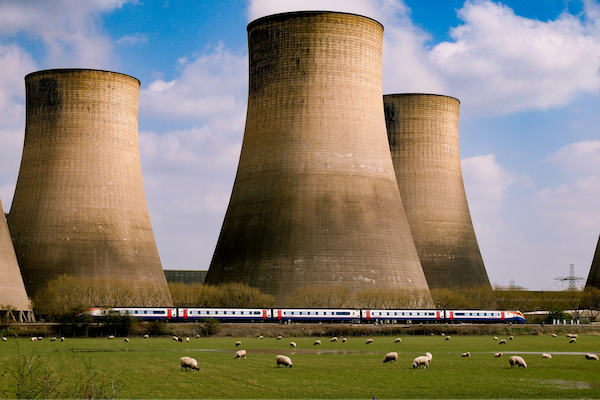 In a recent industry report by Haywood Securities, analysts said the problems in Kazakhstan, plus a buildup of uranium inventory by the Sprott Physical Uranium Trust, could reignite the metal's spot prices near-term and accelerate a permanent shift toward higher prices.
In a recent industry report by Haywood Securities, analysts said the problems in Kazakhstan, plus a buildup of uranium inventory by the Sprott Physical Uranium Trust, could reignite the metal's spot prices near-term and accelerate a permanent shift toward higher prices.
"We maintain a long-term bullish thesis on uranium demand/supply and commodity price and believe this short-term setup could rapidly transform into a mid-term accelerant and market tightening mechanism if there is any production impact in Kazakhstan," Haywood analysts said in the report.
At least 225 people have died and more than 4,300 people have been injured in uprisings of tens of thousands of people in Kazakhstan, The Associated Press reported. Protesters stormed government buildings and set them on fire. It's the largest unrest the country has seen since it gained independence from the Soviet Union three decades ago.
"Uranium is the one energy source that could satisfy every Millennial and Gen-Xer on the planet; zero pollutive impact anywhere and a reliable cost-effective means of heating the planet and recharging Elon Musk’s vehicles."
—Industry observer Michael Ballanger
The demonstrations began over a near-doubling of some fuel prices in the west and quickly spread across the country. The cabinet resigned and a 180-day price cap on vehicle fuel and a moratorium on utility rate increases were announced, but it was unclear what effects those moves would have on the country's stability.
Kazakhstan produces 40% of the world's uranium, about 50.6 million pounds of triuranium octoxide (U3O8) in 2020, according to Haywood.
What Is the Demand for Uranium?
Uranium from mining is used primarily as fuel for nuclear fission in power plants, but it is also used in the medicine, food production, and space industries. There are currently about 440 nuclear reactors operating worldwide, according to the World Nuclear Association. In 2020, they provided about 10% of the world's electricity. About 55 additional plants are being built at a time when conventional coal-fired generation of electricity is simultaneously shrinking.
Most uranium collection is volume-intensive and done through open pit mining. After Kazakhstan, Australia and Canada are the other top-producing countries at 13% and 8%, respectively, according to a report by Kitco Metals Inc.
The sector suffers from stigma surrounding the risk of radiation and accidents — like those at Chernobyl and Three Mile Island — and the element's use to power nuclear bombs. However, the Environment Protection Agency says that uranium is not as dangerous in its exposure profile as other radioactive elements because it decays by alpha particles, and human skin will block the alpha particles.
The industry also points to new studies that show other energy producing sectors are actually much more dangerous than nuclear energy. In fact, the coal industry accounts for as many as 120 deaths per year compared to less than 0.01 deaths per year in the nuclear industry, according to the World Nuclear Association.
Does Uranium Have a Future?
Investors are hoping nuclear power will have a resurgence as governments attempt to turn away from fossil fuels. Uranium prices surged 33% to surpass $40 a pound in September 2021, according to a report by North Shore Global Uranium Mining ETF. They surged again to $45.25 a pound on Jan. 5, Bloomberg reported.
In general, global nuclear power-generating capacity is expected to rise 82% to 792 gigawatts by 2050 as the world transitions from fossil fuels, the International Atomic Agency said.
"Uranium is the one energy source that could satisfy every Millennial and Gen-Xer on the planet; zero pollutive impact anywhere and a reliable cost-effective means of heating the planet and recharging Elon Musk’s vehicles," industry observer Michael Ballanger wrote in December. "Handled properly, nuclear power is truly the alternative for coal and oil and natural gas, but what spooks the world is that the collateral damage of a ruptured nuclear power station is infinitesimally larger than a pipeline leak or a coal fire."
The situation in Kazakhstan could lead to increased dependence on uranium companies in North America and Australia. Haywood's top picks in the sector are NexGen Energy Ltd. (NXE:TSX; NXE:NYSE.MKT), Denison Mines Corp. (DML:TSX; DNN:NYSE.MKT), and Uranium Energy Corp. (UEC:NYSE AMERICAN)
The Haywood analysts pointed to NexGen's Arrow deposit, which they viewed as "the best undeveloped uranium asset globally,” calling it “highly strategic." A February 2021 feasibility study outlined more than 21 million pounds of U3O8 per year over a 10-year mining operation at the site.
"We believe that it is critical for major producers to control this deposit because of its disruptive potential and that this is the strategic key to preserving the value of existing deposits and maintaining the ability to affect price with output decisions," the Haywood analysts reported.
Contributing to uranium's rally is the fact that the Sprott Physical Uranium Trust (SPUT) has gathered 41.3 million pounds of the metal and has grown its assets from $630 million when it launched last summer to more than $2 billion today.
"We are left with a strong setup for uranium bulls short term, with SPUT’s return to the spot market and refortified dry powder as the risk profile of the world’s largest producing nation just increased," Haywood said.
China is reportedly testing another alternative to uranium, thorium. Officials claim the metal is cheaper and creates less radioactive waste. They've already built a reactor for a trial run using it as fuel.
But investors shouldn't let that affect their interest in the uranium industry, analysts said.
"Even if China can prove thorium's success, commercial production is unlikely to start before the end of the decade at the earliest, given that it can take years to assess the environmental impact of any nuclear fuel," Neha Chamaria at The Motley Fool wrote. "It's unlikely to replace uranium altogether, especially with nuclear energy gaining attention among some economies across the globe as a viable clean-energy option to meet their goals for greenhouse gas emissions."
Disclosures:
1) Steve Sobek compiled this article for Streetwise Reports LLC and provides services to Streetwise Reports as an independent contractor. He or members of his household own securities of the following companies mentioned in the article: None. He or members of his household are paid by the following companies mentioned in this article: None.
2) The following companies mentioned in this article are billboard sponsors of Streetwise Reports: None. Click here for important disclosures about sponsor fees. The information provided above is for informational purposes only and is not a recommendation to buy or sell any security.
3) The article does not constitute investment advice. Each reader is encouraged to consult with his or her individual financial professional and any action a reader takes as a result of information presented here is his or her own responsibility. By opening this page, each reader accepts and agrees to Streetwise Reports' terms of use and full legal disclaimer. This article is not a solicitation for investment. Streetwise Reports does not render general or specific investment advice and the information on Streetwise Reports should not be considered a recommendation to buy or sell any security. Streetwise Reports does not endorse or recommend the business, products, services or securities of any company mentioned on Streetwise Reports.
4) From time to time, Streetwise Reports LLC and its directors, officers, employees or members of their families, as well as persons interviewed for articles and interviews on the site, may have a long or short position in securities mentioned. Directors, officers, employees or members of their immediate families are prohibited from making purchases and/or sales of those securities in the open market or otherwise from the time of the decision to publish an article until three business days after the publication of the article. The foregoing prohibition does not apply to articles that in substance only restate previously published company releases. As of the date of this article, officers and/or employees of Streetwise Reports LLC (including members of their household) own securities of Uranium Energy Corp., which is a company mentioned in this article.
Disclosures from Haywood Securities, Jan. 6, 2022
This report is intended for institutional investors and may only be distributed to non-institutional U.S. clients in the following states: nil. Otherwise, this report may only be distributed into those states with an institutional buyer state securities registration exemption.
Analyst Certification: I, Colin Healey, hereby certify that the views expressed in this report (which includes the rating assigned to the issuer's shares as well as the analytical substance and tone of the report) accurately reflect my/our personal views about the subject securities and the issuer. No part of my/our compensation was, is, or will be directly or indirectly related to the specific recommendations.
Haywood Securities, Inc. has reviewed lead projects of these companies and a portion of the expenses for this travel may have been reimbursed by the issuer: Denison Mines Corp., NexGen Energy Ltd., and Uranium Energy Corp. Haywood Securities Inc. or one of its subsidiaries has managed or co-managed or participated as selling group in a public offering of securities for these companies in the past 12 months: Denison Mines Corp., and NexGen Energy Ltd. Haywood Securities, Inc. or one of its subsidiaries has received compensation for investment banking services from this company in the past 12 months: Denison Mines Corp.


